
Grafham Water is an 806.3-hectare (1,992-acre) biological Site of Special Scientific Interest (SSSI) north of Perry, Huntingdonshire. It was designated an SSSI in 1986. It is a reservoir with a circumference of about 16 km (10 mi), is 21 m (69 ft) deep at maximum, and is the eighth largest reservoir in England by volume and the third largest by area at 6.27 km2. An area of 114 ha at the western end is a nature reserve managed by the Wildlife Trust for Bedfordshire, Cambridgeshire and Northamptonshire.
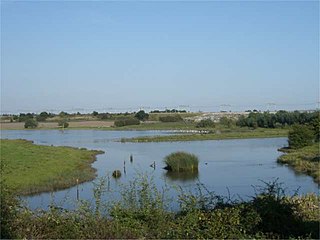
Sandbach Flashes are a group of 14 wetlands west of Sandbach in Cheshire, England. The flashes were designated as a Site of Special Scientific Interest in 1963, with a total area of 1.53 km2. There are a number of individual flashes including Bottom's Flash, Crabmill Flash, Elton Hall Flash, Fodens Flash, Groby's Flash, Ilse Pool, Moston Flashes, Pump House Flash, Railway Flash, Red Lane Tip and Pool, and Watch Lane Flash.
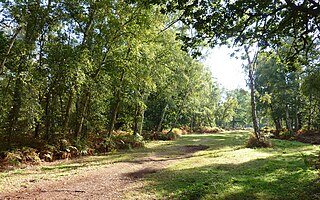
The Great Fen is a habitat restoration project being undertaken on The Fens in the county of Cambridgeshire in the United Kingdom. It is one of the largest restoration projects in the country, and aims to create a 3,700 hectare wetland and aims to connect Woodwalton Fen National Nature Reserve (NNR), Holme Fen NNR and other nature reserves to create a larger site with conservation benefits for wildlife and socio-economic benefits for people.

Noar Hill is a 63-hectare (160-acre) biological Site of Special Scientific Interest south of Selborne in Hampshire. It is a Nature Conservation Review site, Grade 2, and part of East Hampshire Hangers Special Area of Conservation. An area of 20 hectares is a nature reserve managed by the Hampshire and Isle of Wight Wildlife Trust.
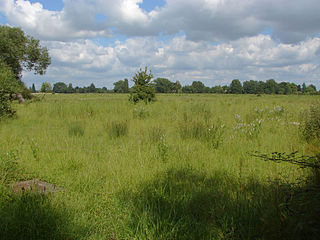
Thorpe Hay Meadow is a 6.4-hectare (16-acre) biological Site of Special Scientific Interest west of Staines-upon-Thames in Surrey. It is owned and managed by the Surrey Wildlife Trust.

Dropshort Marsh is a 2.7-hectare (6.7-acre) biological Site of Special Scientific Interest in Toddington in Bedfordshire. It was notified under Section 28 of the Wildlife and Countryside Act 1981 in 1985, and the local planning authority is Central Bedfordshire Council. The site is managed by the Wildlife Trust for Bedfordshire, Cambridgeshire and Northamptonshire.
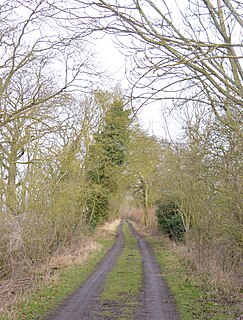
Hayley Wood is a 51.7-hectare (128-acre) biological Site of Special Scientific Interest south-east of Great Gransden in Cambridgeshire. It is a Nature Conservation Review site, Grade 1, and it is managed by the Wildlife Trust for Bedfordshire, Cambridgeshire and Northamptonshire. It was the subject of a book by the academic and woodland expert Oliver Rackham, listed below.
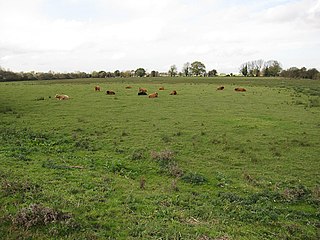
Soham Wet Horse Fen is a 33.8-hectare (84-acre) biological Site of Special Scientific Interest east of Soham in Cambridgeshire. A 3.6-hectare (8.9-acre) field in the north-west corner is managed by the Wildlife Trust for Bedfordshire, Cambridgeshire and Northamptonshire as Soham Meadow.

Barnack Hills & Holes is a 23.3-hectare (58-acre) biological Site of Special Scientific Interest in Barnack in Cambridgeshire. It is also a national nature reserve. It is a Nature Conservation Review site, Grade I. In 2002 it was designated as a Special Area of Conservation, to protect the orchid-rich grassland as part of the Natura 2000 network of sites throughout the European Union.

Castor Hanglands is an 89.8-hectare (222-acre) biological Site of Special Scientific Interest west of Peterborough in Cambridgeshire. The site is also a National Nature Reserve, and it is a Nature Conservation Review site, Grade I for its woodlands and Grade 2 for its grassland. It is common land managed by Natural England.

Thompson Water, Carr and Common is a 154.7-hectare (382-acre) biological Site of Special Scientific Interest north of Thetford in Norfolk. Most of it is managed by the Norfolk Wildlife Trust as Thompson Common. It is a Nature Conservation Review site, Grade I, and part of the Norfolk Valley Fens Special Area of Conservation. It is crossed by the Great Eastern Pingo Trail Local Nature Reserve.
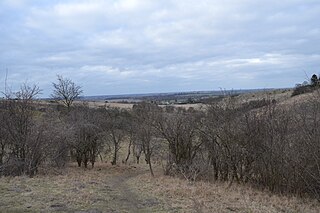
Deacon Hill SSSI is a 35.4 hectare biological Site of Special Scientific Interest in Pegsdon in Bedfordshire. It is in the Chilterns Area of Outstanding Natural Beauty, and it is part of the Pegsdon Hills and Hoo Bit nature reserve, managed by Wildlife Trust for Bedfordshire, Cambridgeshire and Northamptonshire.

Tanymastix stagnalis is a species of Anostraca that lives in temporary pools across Europe. It may reach up to 2 cm (0.8 in) in some areas and has 11 pairs of bristly, flattened appendages. It swims upside-down and filters food particles from the water. It is the only species of Anostraca in Ireland, having been discovered in Rahasane turlough in 1974.

Chirocephalus diaphanus is a widely distributed European species of fairy shrimp that lives as far north as Great Britain, where it is the only surviving species of fairy shrimp and is protected under the Wildlife and Countryside Act 1981. It is a translucent animal, about 0.5 in (13 mm) long, with reddened tips to the abdomen and appendages. The body comprises a head, a thorax bearing 11 pairs of appendages, and a seven-segmented abdomen. In males, the antennae are enlarged to form "frontal appendages", while females have an egg pouch at the end of the thorax.

Black Lake is a nature reserve in Delamere Forest, Cheshire, England. It lies in the southwestern corner of the forest, just south of the Manchester–Chester railway. It is managed by the Cheshire Wildlife Trust (CWT) on behalf of the Forestry Commission, and as a Site of Special Scientific Interest (SSSI) is monitored by Natural England.
Rhosydd Llanpumsaint is a Site of Special Scientific Interest (SSSI) in Carmarthenshire, Wales.

Thriplow Meadows is a 3.5-hectare (8.6-acre) biological Site of Special Scientific Interest in Thriplow in Cambridgeshire.

Godmanchester Eastside Common is a 29.7-hectare (73-acre) biological Site of Special Scientific Interest east of Godmanchester in Cambridgeshire. The site is registered common land.
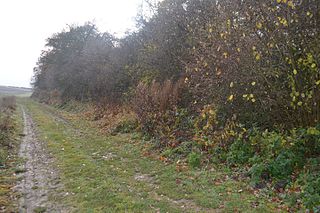
Elsworth Wood is a 6.9-hectare (17-acre) biological Site of Special Scientific Interest between Cambourne and Elsworth in Cambridgeshire.


















